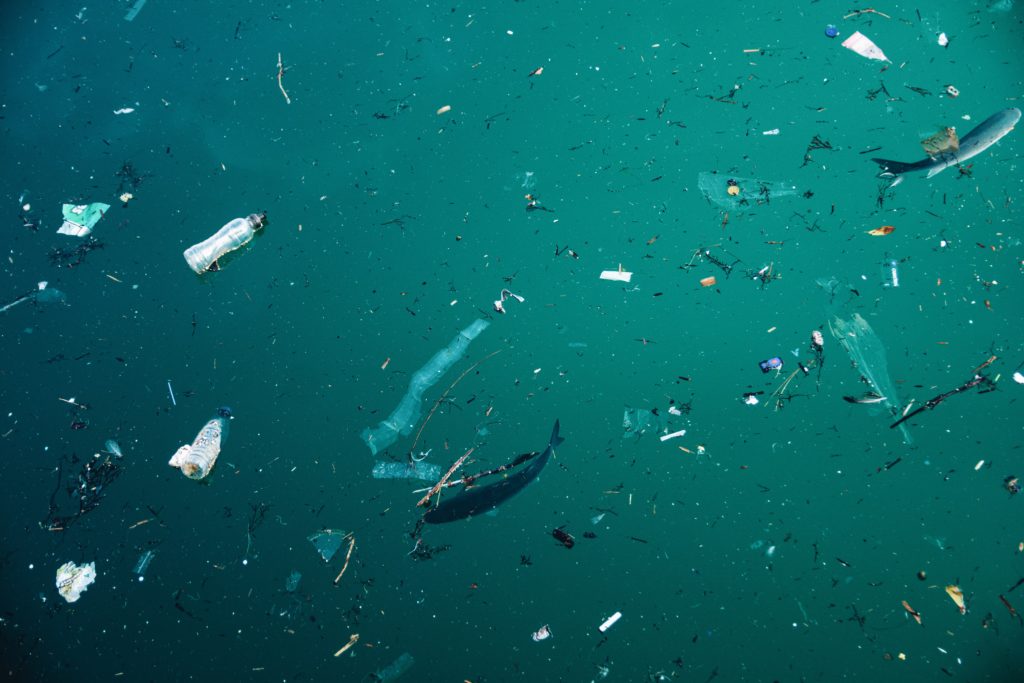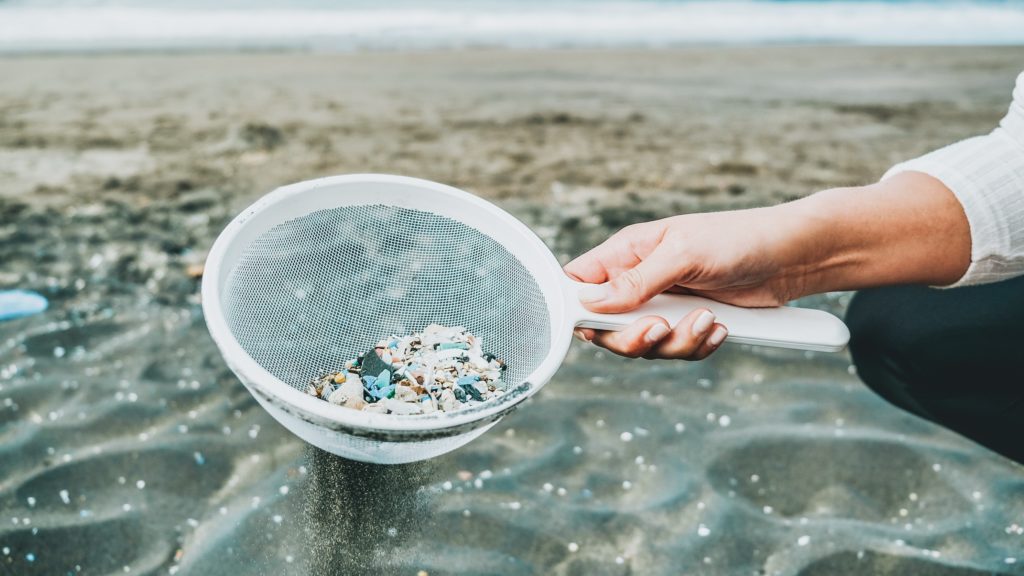Updated April 29, 2021. You could be eating up to five grams of microplastics — the approximate equivalent of a credit card — every single week. But you might be wondering: what exactly are microplastics, and why does it matter?
Microplastics are small pieces of plastic less than 5mm in size, and can be anything from microscopic to the length of a grain of rice. Because plastic can take hundreds of years to biodegrade, each piece of microplastic simply gets smaller and smaller, circulating indefinitely.
These tiny plastics are already widespread in the natural environment and can be found in oceans, rivers, rain, ice cores, plants, wild animals, and even the air we breathe.
A recent study, published by the peer-reviewed journal Proceedings of the National Academy of Sciences, reported that “plastics now spiral around the globe” in the atmosphere like gas and other particulates — blown by the wind and falling to earth with rain.
Previous research indicates that wind-blow microplastics could be falling on protected regions of the central and southern U.S. at a rate of over 1,000 tons every year. The majority of atmospheric plastics are legacy pollution, initially generated via road, marine, agriculture, and dust emissions downwind of population centers.
It’s because of this all-pervasive circulation that microplastics can be found in us too. According to a study from 2019 titled No Plastic in Nature: Assessing Plastic Ingestion from Nature to People — commissioned by the World Wildlife Fund (WWF) and carried out by the University of Newcastle, Australia — people consume, on average, around 2000 tiny pieces of plastic every seven days. That’s around 21 grams per month, and just over 250 grams per year.
No Plastic in Nature, which is based on the conclusions of 52 other studies, suggests that the exact amount of plastic pollution varies from location to location. But nowhere is completely untouched. In the U.S., around 94.4 percent of tap water samples contained plastic fibres, with an average of 9.6 fibers per litre.
So where do these microplastics actually come from, and how do they end up in our water — and our bodies?

What are microplastics and where do they come from?
Plastic was invented in the late 19th century, but production didn’t begin in earnest until the 1960s. Combined with the birth of throw-away-culture the decade before, it only took until the 1970s for landfills to start overflowing.
As the new report says, “plastic is used as a disposable material, to such an extent that over 75 percent of all plastic ever produced is waste.”
“Researchers estimate that more than 8.3 billion tonnes of plastic has been produced since the early 1950s,” confirms the UN Environment Program (UNEP). “About 60% of that plastic has ended up in either a landfill or the natural environment.”
Microplastics are not a recent problem, either, and they first appeared in personal care products approximately 50 years ago. The tiny pieces of polythene were and are used as exfoliants in many health and beauty items such as cleansers, soaps, and toothpaste. Because of their size, they easily bypass traditional water filtration systems and then enter the global supply.
Microplastics can also enter the water system via wastewater overflows and in run-off from industrial, agricultural, and domestic sources. Because of this, laundry is another key contributor to microplastic distribution, and many of the plastic fibres contained in clothing — particularly fast fashion, sports, and athleisure items — enter the water system this way.
Larger pieces of debris sometimes degrade and break down before being dispersed as microplastics, too. The largest ocean-based source of plastic pollution is seafood production, and the fishing industry alone is thought to be responsible for more than 640,000 tonnes of nets, traps, lines, and other toxic pollutants that end up in the oceans every year.

Microplastics in the environment
According to the UN, plastic makes up approximately 80 percent of all ocean litter. That’s up to 51 trillion microplastic particles — 500 times more pieces of plastic than there are stars in our galaxy. If this current trend continues, oceans will contain more plastic than fish by 2050.
Plastic harms the ocean and its flora and fauna in countless ways, and underwater currents can cause debris to cover and degrade delicate habitats such as coral reefs. Marine animals can easily become tangled in fishing equipment and other detritus, while some forms of sea life consume the microplastics now present in their ecosystems. This is also true for terrestrial animals.
“Many of these tiny plastic particles are swallowed by farm animals or fish who mistake them for food,” says UNEP. “And thus can find their way onto our dinner plates.”
Microplastics in food
So plastic is now present in wildlife and farm animals. But eating meat is not the only way that these microplastics get into our bodies. The tiny pollutants are also found in fruit and vegetables such as carrots, lettuce, pears, and apples — the latter with an average of 195,500 plastic particles per gram.
“MPs are capable to penetrate the seed, root, culm, leaves and fruits plant cell based on their size and type,” reads a study produced by researchers at the University of Catania, Italy. “[The] results open a new scenario both in environmental and medical sciences.”
While the extent to which microplastics harm humans hasn’t yet been adequately studied, existing research does show that the consumption of plastic particles severely damages the health of wildlife — in particular, causing neurotoxicity, oxidative damage, and intestinal deformities in fish.
Plastic may contain additives that are already proven to be toxic or harmful to humans — including BPA, PVC, and DBT — as well as persistent organic pollutants such as pesticides that can attach themselves to debris. Styrene, in particular, has been linked to health issues such as cancer, hearing loss, and nervous system problems.

The plastics of the future
The science of biodegradable and compostable plastics is constantly evolving, and new and innovative solutions could present alternatives to traditional production.
University of Cambridge-affiliated firm Xampla recently began using plant-based pea protein — the same hero ingredient used by Beyond Meat — to replace microplastics in everyday items. The company’s plant protein-based “plastic” decomposes completely in just a few weeks, in stark contrast with long-lasting petroleum-based plastics.
But while science can help make plastics more sustainable, this isn’t the entire solution, and existing plastics in the environment must be effectively managed. Dominic Waughray of the World Economic Forum says the world needs a plastic “revolution.”
“To move from insight to large scale action, it is clear that no one actor can work on this alone,” says Waughray. “The public, private sector, and civil society all need to mobilize in order to capture the opportunity of the new circular plastics economy.”
In 2019, Irish inventor Fionn Ferreira created a way of magnetizing microplastics in order to remove them from water, with a success rate of up to 88 percent. Other possibilities include nanoplastic nets, and screens that can filter out plastic-based dust.
What can we do about microplastics?
Scientific and industry breakthroughs, plastic bans, and other governmental interventions can all help to mitigate the impact of plastic on the environment. But there’s plenty that people can do themselves, at home or out and about, to reduce the spread of microplastics.
Wet wipes, contact lenses, sanitary products, dental floss, and any other personal care items should always be disposed of properly — not flushed down the toilet. These products can cause blockages and flooding, and frequently end up in public waterways where they will negatively impact the flora and fauna.
In general, recycling as much as possible and disposing of everything safely when you have to can minimize its environmental impact. And when you do have to buy something new, such as clothing, choosing a more sustainable option — perhaps made with natural fibres — makes a big difference.
Washing clothes less often — and with a full machine — will also cut back on microplastics. You can purchase several different styles of attachment for home washing machines that trap additional microfibres and other particles for easy, safe, disposal. And air drying your clothing also makes a huge difference.
Cutting back on all single-use plastics (where possible), and emphasizing reusable containers such as glass can help to reduce the continued production of microplastics. But this can also help to minimize your own exposure. Here are some key ways to reduce the quantity of microplastics in your life.

Cut back on plastic in the kitchen
Reducing the quantity of plastic in your kitchen significantly cuts back on waste and lowers your exposure to potentially toxic substances. Approximately 40 percent of produced plastic is used for packaging, much of it unnecessary. While polyethylene, the material used in plastic bags and storage containers, is by far the most common polymer in marine microplastic debris.
Some easy ways to keep plastic out of your diet (and the environment) include:
- Avoid drinking bottled water
- Filter your tap water
- Don’t heat or reheat food in plastic containers
- Definitely avoid plastics with known toxins (such as BPA)
- Eat fresh food instead of processed or packaged items (where possible)
- And shop more sustainably by emphasizing zero waste options

Make your beauty regime zero-waste (or close)
Avoiding artificial microbeads is better for both you and the environment, and many modern brands now use natural alternatives such as oats, sugar, and husks. But in addition to exfoliating products, microplastics are sometimes used as emulsifying agents or cheap fillers, or for aesthetic reasons in glittery items. Swap unsustainable for biodegradable and be aware of Beat the Micro Bead’s “Look for the Zero” logo.

Keep a clean home
Cleaning might not be very exciting, but it could significantly reduce your overall exposure to microplastics. A study from last year published in ScienceDirect found plastic particles in household dust across 12 different countries, indicating that they are global indoor pollutants. It also found that ingestion rates were higher for infants, and that overall household dust is a key exposure route for microplastics in humans.

Cut out animal products
Seafood and fish are other key sources of microplastic ingestion in humans, and a single portion of consumer-grade mussels in the EU contains up to 90 pieces of microplastic. But other animals also contain microplastics, including pigs, sheep, and cows.
As with fish, humans typically do not consume terrestrial animals’ digestive systems, but other internal organs have also been found to contain microplastics. Studies indicate that the packaging used for meat products — particularly extruded polystyrene trays — also contributes to microplastic ingestion.
Overall, eating fresh, unprocessed, plant-based, whole foods as much as possible could help to reduce exposure to microplastics via food. And cutting out seafood such as shelfish, in particular, will minimize microplastic consumption.
Microplastics are everywhere, and the sheer scale of this issue can feel intimidating. But there are plenty of ways to mitigate both your own exposure and your contribution to microplastic pollution, in general.
Joining recycling and zero-waste groups can also be helpful and create community support networks based around reducing pollution and improving personal and environmental health.


